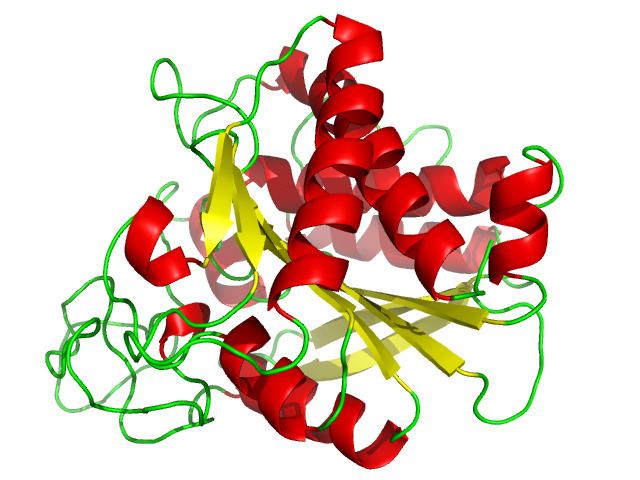 | ||
A carboxypeptidase (EC number 3.4.16 - 3.4.18) is a protease enzyme that hydrolyzes (cleaves) a peptide bond at the carboxy-terminal (C-terminal) end of a protein or peptide. (Contrast with an aminopeptidase, which cleaves peptide bonds at the other end of the protein.) Humans, animals, and plants contain several types of carboxypeptidases that have diverse functions ranging from catabolism to protein maturation.
Contents
Functions
The first carboxypeptidases studied were those involved in the digestion of food (pancreatic carboxypeptidases A1, A2, and B). However, most of the known carboxypeptidases are not involved in catabolism; they help to mature proteins (e.g., Post-translational modification) or regulate biological processes. For example, the biosynthesis of neuroendocrine peptides such as insulin requires a carboxypeptidase. Carboxypeptidases also function in blood clotting, growth factor production, wound healing, reproduction, and many other processes. Citation ?
By active site mechanism
Carboxypeptidases are usually classified into one of several families based on their active site mechanism.
These names do not refer to the selectivity of the amino acid that is cleaved.
By substrate preference
Another classification system for carboxypeptidases refers to their substrate preference.
A metallo-carboxypeptidase that cleaves a C-terminal glutamate from the peptide N-acetyl-L-aspartyl-L-glutamate is called "glutamate carboxypeptidase".
A serine carboxypeptidase that cleaves the C-terminal residue from peptides containing the sequence -Pro-Xaa (Pro is proline, Xaa is any amino acid on the C-terminus of a peptide) is called "prolyl carboxypeptidase".
Activation
Some, but not all, carboxypeptidases are initially produced in an inactive form; this precursor form is referred to as a procarboxypeptidase. In the case of pancreatic carboxypeptidase A, the inactive zymogen form - pro-carboxypeptidase A - is converted to its active form - carboxypeptidase A - by the enzyme trypsin. This mechanism ensures that the cells wherein pro-carboxypeptidase A is produced are not themselves digested.
